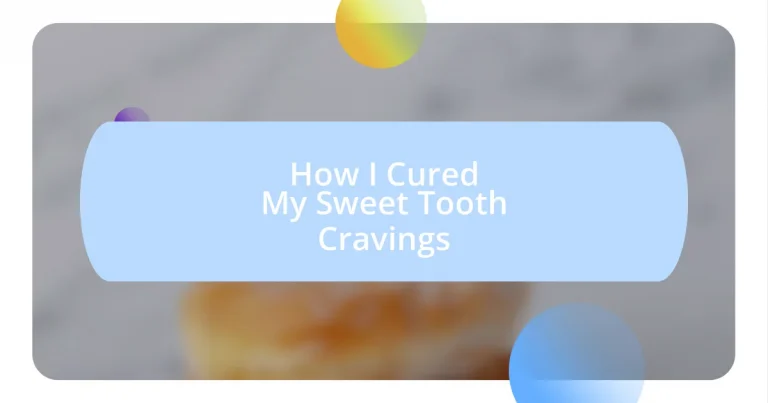Key takeaways:
- Sweet tooth cravings are influenced by emotional states, habits, and environmental cues; recognizing these triggers can help manage them effectively.
- Substituting traditional sweets with healthier alternatives, like fresh fruit and yogurt, can satisfy cravings without the guilt of processed sugars.
- Sustaining long-term success involves creating a supportive food environment, celebrating small victories, and maintaining a flexible mindset regarding occasional indulgences.
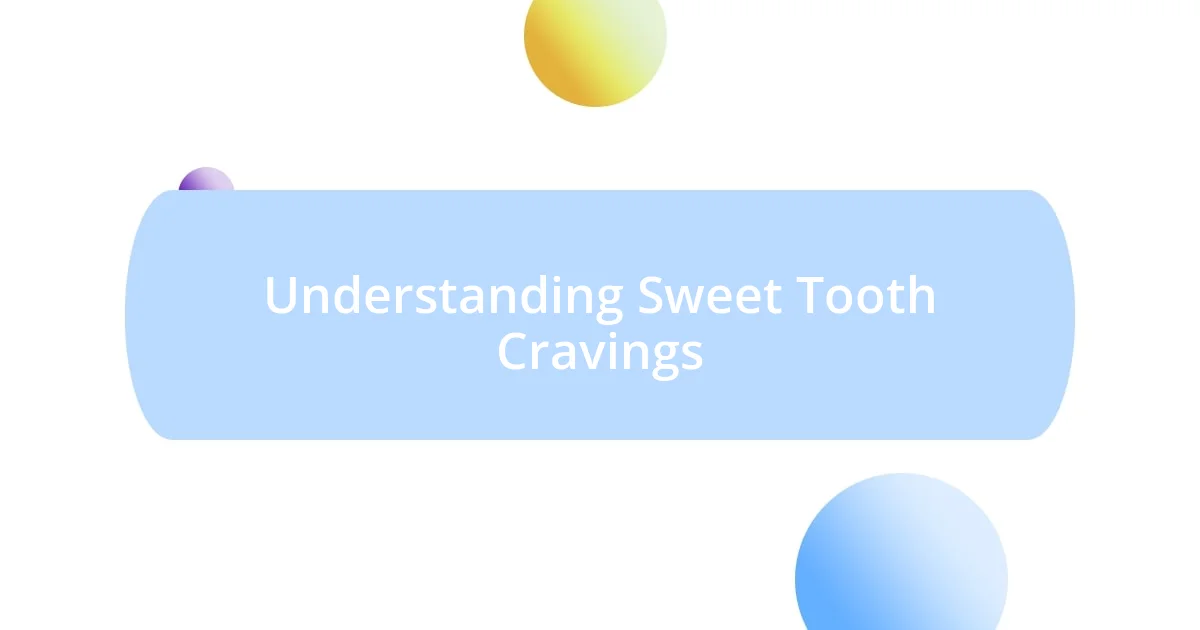
Understanding Sweet Tooth Cravings
Sweet tooth cravings often stem from a complex interplay of biology and psychology. I remember one night, feeling overwhelmed with the urge for something sugary, I realized that my cravings weren’t just about hunger; they were tied to my emotions. Have you ever noticed how stress or sadness can send you rummaging through the pantry for that box of cookies?
I’ve learned that our brains release feel-good chemicals, like dopamine, when we consume sugar. It’s a quick reward that can momentarily lift our mood. But what happens when those sugary treats become a go-to solution for stress? I began to notice that I turned to sweets not just for taste, but because they provided comfort.
Moreover, having a sweet tooth can be influenced by habits formed throughout our lives. For instance, growing up, dessert was always the highlight of family dinners. I’ve had to ask myself, do these memories shape my cravings today? Understanding where these cravings come from can empower us to create healthier practices around food.
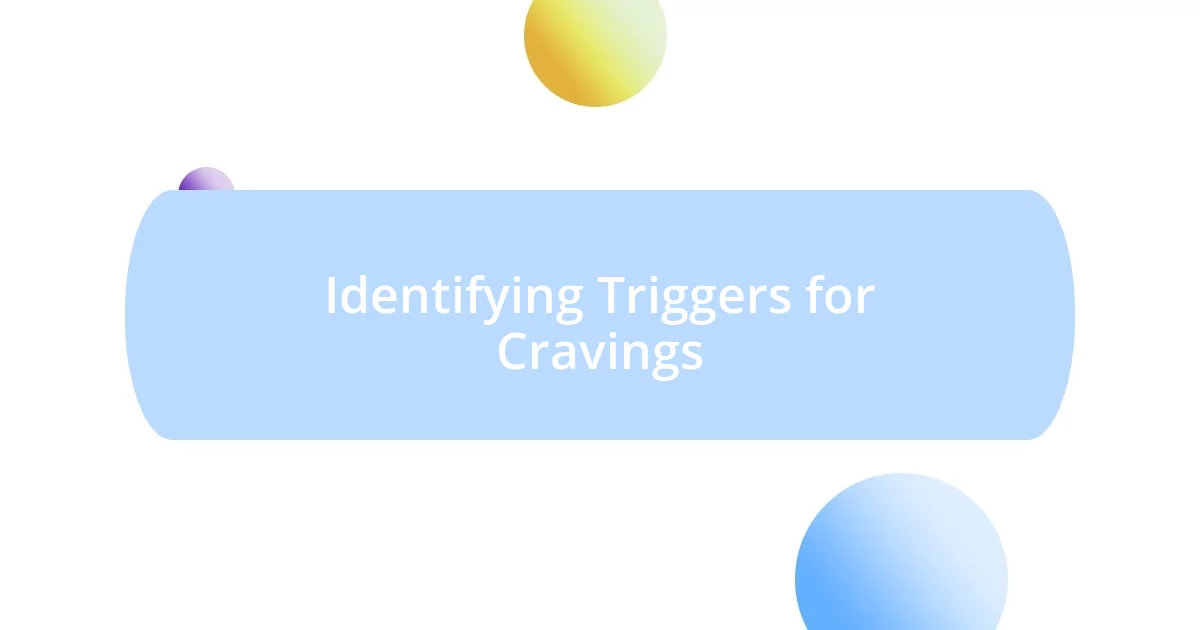
Identifying Triggers for Cravings
Identifying the triggers for my sweet tooth cravings has been a journey of self-discovery. I found it crucial to pay attention to the moments when those cravings hit hardest. For instance, there were afternoons when I’d be sitting at my desk, buried in work, and suddenly I’d crave something sweet. I realized that fatigue and long hours often led me to seek quick energy boosts through sugary snacks.
To help pinpoint my cravings, I started keeping a small journal to note down common triggers. Here’s what I found:
- Emotional States: Stress or boredom often prompted me to reach for sweets.
- Environmental Cues: Simply walking by the bakery section at the grocery store would ignite cravings.
- Social Situations: Celebrations or gatherings where dessert is present would create an urge to indulge.
- Routine Habits: Watching TV in the evening became synonymous with snacking on chocolate.
Recognizing these patterns has made a significant impact on how I manage my cravings. It’s amazing how understanding triggers can empower us to make better choices.
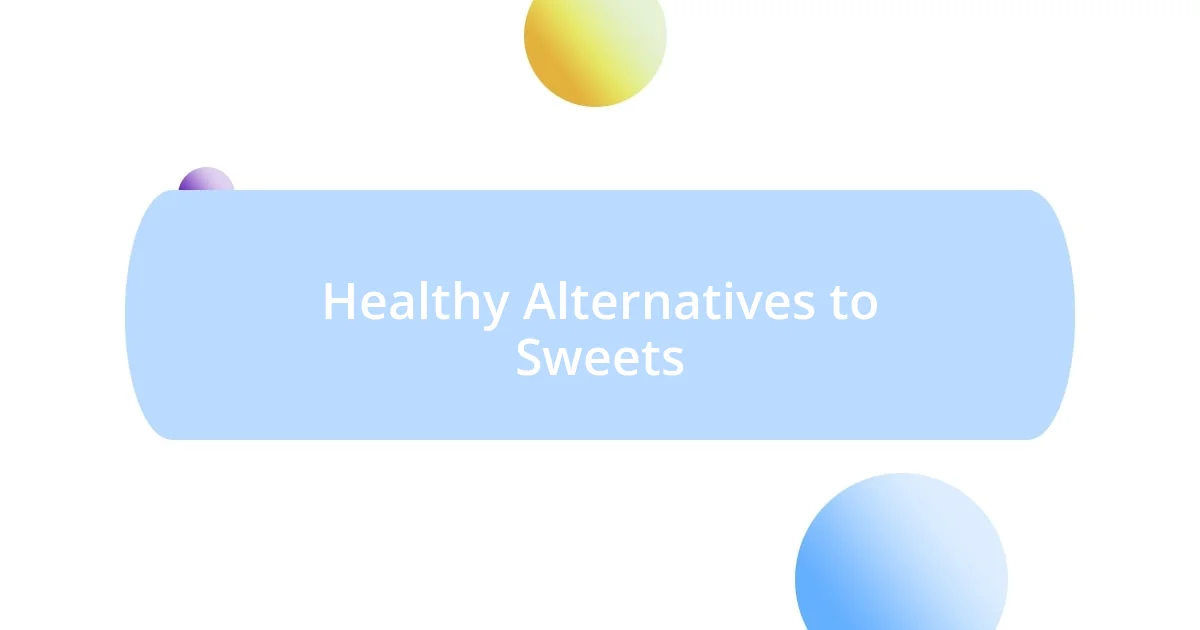
Healthy Alternatives to Sweets
Finding healthier alternatives to sweets can dramatically change how we experience cravings. Instead of reaching for that chocolate bar, I’ve discovered that fresh fruit can do the trick. I remember one time feeling the urge for something sweet, so I grabbed a handful of berries instead. The natural sweetness of the fruit satisfied my cravings without the added guilt that often comes with processed sugars.
Another fantastic option I’ve embraced is yogurt with a sprinkle of nuts or seeds. Sometimes, I mix in a bit of honey or a dash of cinnamon. Not only does it taste delicious, but it also provides protein and healthy fats, keeping me fuller for longer. Have you ever tried frozen banana slices? They make a fantastic alternative to ice cream! I was genuinely surprised at how satisfying they were when I felt like indulging in something cold and sweet.
It’s remarkable how we can rewire our taste preferences with a bit of creativity and intentionality. For example, I started experimenting with dark chocolate. A small piece of high-quality dark chocolate can curb the urge without leading to a sugar crash later. When we seek pleasure in our food, it’s perfectly okay to swap out what doesn’t serve us.
| Traditional Sweet | Healthy Alternative |
|---|---|
| Chocolate Bar | Fresh Fruit |
| Ice Cream | Frozen Banana Slices |
| Yogurt with Sugar | Yogurt with Nuts/Seeds |
| Processed Candy | Dark Chocolate |
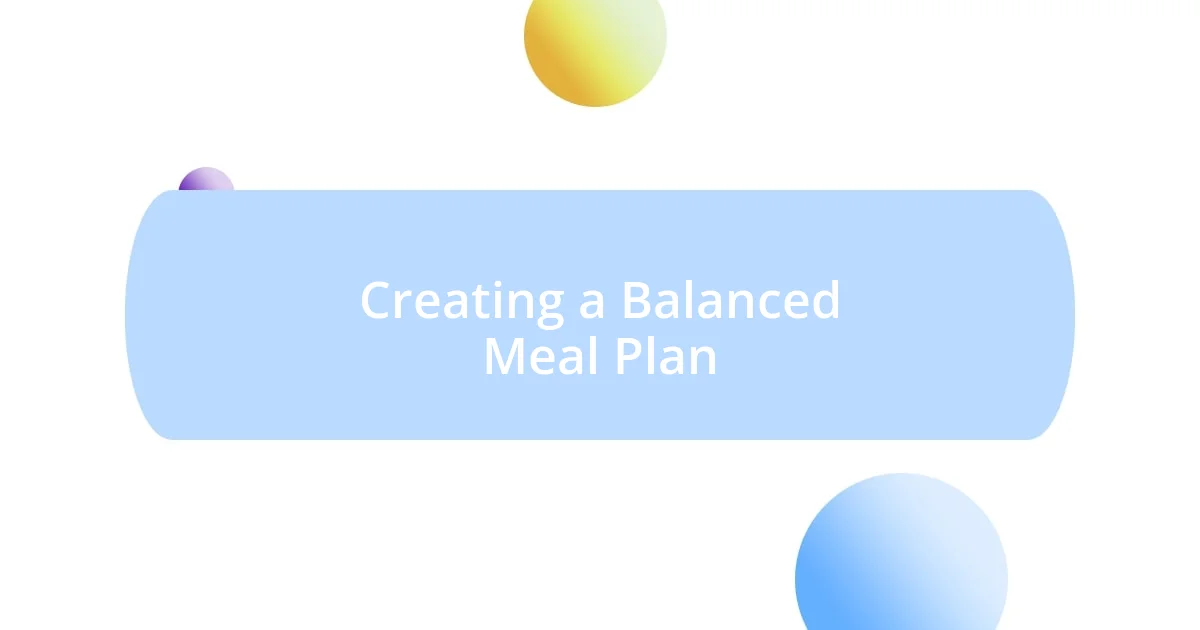
Creating a Balanced Meal Plan
Creating a balanced meal plan is a game changer when it comes to managing sweet tooth cravings, and I learned this firsthand. I began by incorporating a variety of food groups to ensure I was getting the right nutrients. For example, I started every day with a hearty breakfast that included protein, whole grains, and healthy fats. This way, I didn’t just set myself up for a sugar crash later; I felt energized and satisfied, which made it easier to resist those sweet temptations that would usually call my name.
I noticed that my lunch routine also made a significant impact. Instead of opting for a quick sandwich, I began preparing colorful salads with a mix of veggies, lean proteins, and whole grains. It was eye-opening to see the difference it made! I mean, have you ever really savored a rainbow on your plate? Those vibrant veggies not only looked appealing but also kept my hunger at bay, which in turn led to fewer cravings in the afternoons. Preparing meals became almost meditative for me; it was a way to connect with the food I was eating and to make better choices that aligned with my goals.
Evening meals now consist of filling dishes that combine protein, fiber, and healthy fats. I’ve found that including a small portion of healthy carbohydrates, like quinoa or sweet potatoes, truly rounds out my plate. It’s all about balance, right? The best part is that I feel satisfied after dinner, which means I’m less likely to rummage through the pantry for sweets later. It’s like discovering a hidden treasure in the kitchen—not only do I enjoy cooking, but I also enjoy the results! What have you found works for you?
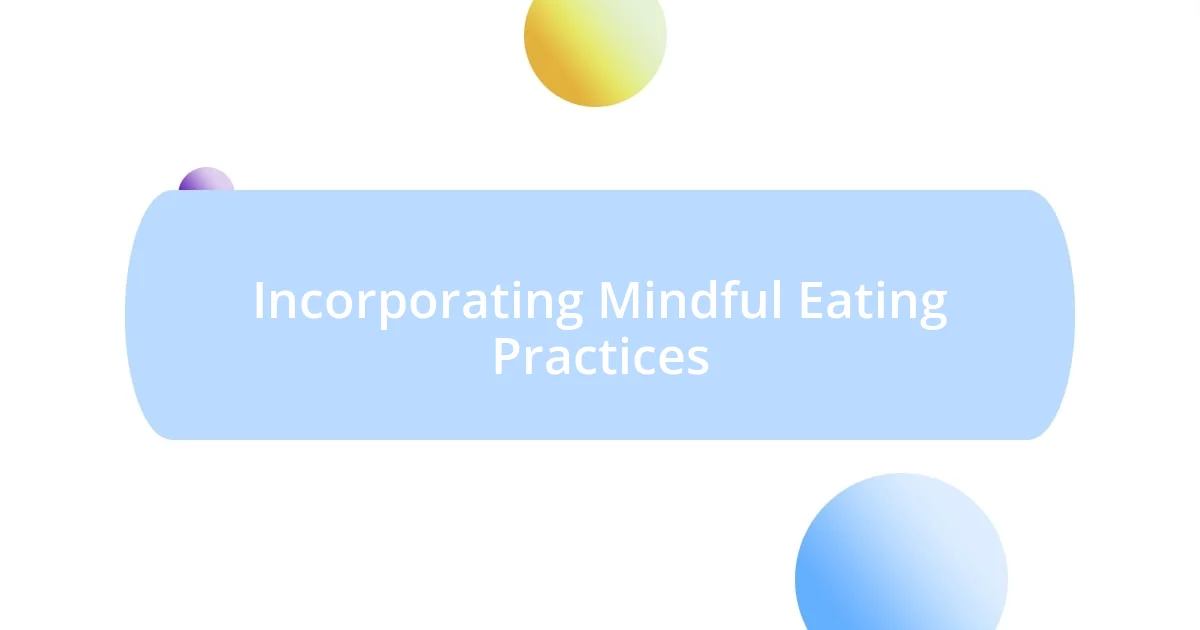
Incorporating Mindful Eating Practices
Incorporating mindful eating practices has been a revelation for me. Instead of mindlessly munching on snacks while watching TV, I now make a conscious effort to truly savor each bite. I often find myself asking, “How does this taste?” It sounds simple, but paying attention to the flavors and textures has transformed how I enjoy food. I remember sitting at a café with a piece of cake, allowing myself to experience its richness and sweetness, rather than just gobbling it down.
I also practice the habit of eating in a distraction-free environment. By eliminating screens and focusing solely on my meal, I’ve noticed I become more attuned to my hunger cues. This shift has helped me recognize when I’m genuinely hungry versus when I’m just looking for a sugar hit. I vividly recall a dinner where I took the time to appreciate the colors on my plate and the aromas wafting up; it felt like an enjoyable experience rather than a routine chore.
Mindful eating doesn’t just mean paying attention during meals; it extends to snack time, too. Instead of reaching for sweets out of habit, I ponder what I really want. One afternoon, while I was contemplating a candy bar, I paused and grabbed a handful of nuts instead. The crunchy texture and satisfying flavors filled me up, proving once again that a moment of reflection can lead to a healthier choice. Isn’t it empowering to realize that we have the power to steer our cravings in a different direction?
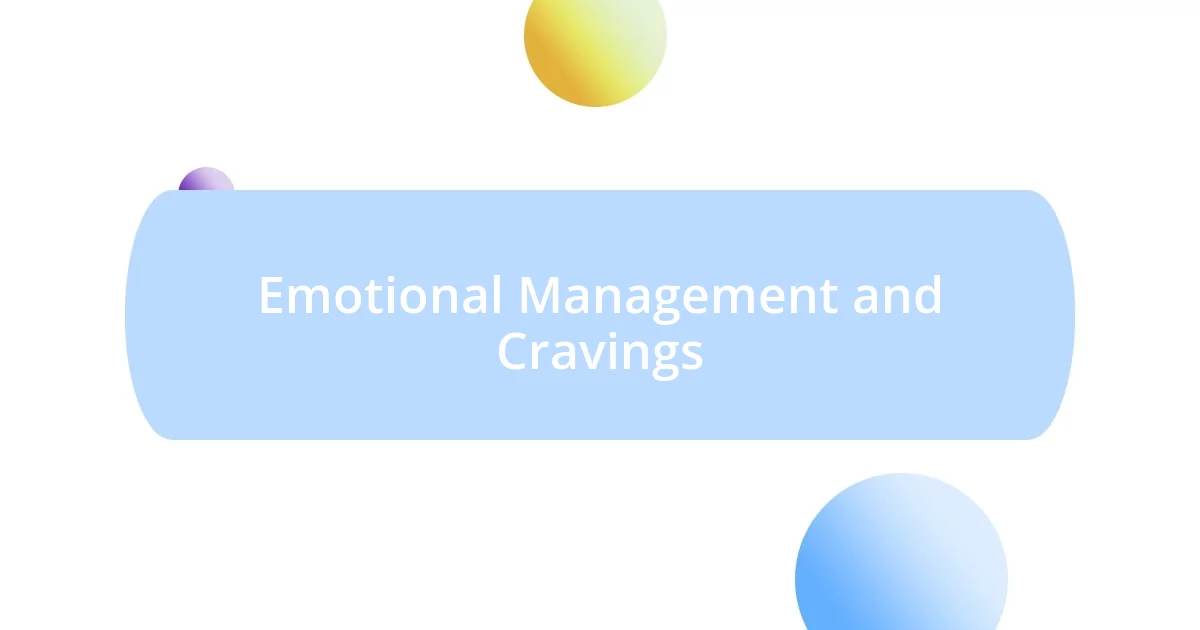
Emotional Management and Cravings
Learning to manage my emotions has played a crucial role in taming my sweet tooth cravings. I vividly remember feeling overwhelmed after a long day at work, and I would reflexively reach for chocolate to soothe my stress. It was in those moments of exhaustion that I realized I was using food as an emotional crutch rather than addressing what I truly needed—rest and self-care. When I shifted my focus to healthier coping strategies, like taking a walk or practicing deep breathing, I found those cravings began to fade. Have you ever noticed how your mood affects your desire for sugary treats?
I also discovered that keeping a journal helped me gain insight into the triggers behind my cravings. When I started jotting down my feelings and cravings, it was eye-opening. I noticed patterns: stress led to cravings, while moments of joy didn’t. By identifying these emotional connections, I learned to pause and ask myself, “Am I really hungry, or is this just a response to what I’m feeling?” This small step made a world of difference, allowing me to address my emotions in healthier ways rather than relying on sugar to fill a void.
Another powerful strategy I adopted involved replacing the act of snacking with activities that brought me joy. Instead of defaulting to cookies when I felt bored or restless, I began diving into hobbies like painting or reading. There was something special about engaging creatively that satisfied my need for comfort without resorting to sweets. Honestly, after finishing a painting session, the thrill and fulfillment I felt overshadowed any lingering desire for dessert. Isn’t it amazing how channeling our emotions into something productive can reshape our cravings?
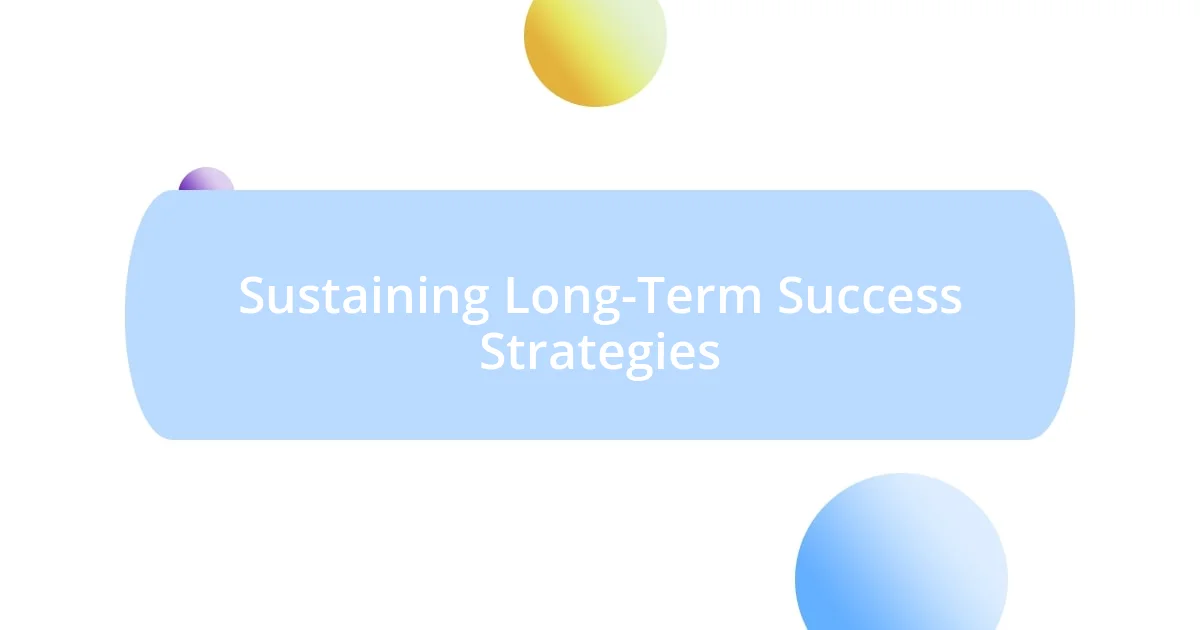
Sustaining Long-Term Success Strategies
One of the most effective strategies I’ve found for sustaining long-term success is creating a balanced environment around food choices. I learned the hard way that having tempting snacks within arm’s reach can lead to impulsive decisions. I remember one Friday evening, after a long week, I reached into my pantry and found a bag of cookies. Instead of indulging, I decided to replace those cookies with fresh fruits and nuts. It felt empowering to transform my space into one that supports my goals. Have you considered how your surroundings dictate your choices?
Another key to long-term success is celebrating small victories along the way. I distinctly recall a week when I decided to skip dessert entirely, and by the end of it, I felt accomplished and proud. Recognizing when I resist cravings or choose healthier options gives me a boost of motivation. Rewarding myself with non-food-related treats, like a new book or a relaxing evening, reinforces my commitment. It’s fascinating how such simple acknowledgments can ignite our determination, isn’t it?
Lastly, I believe maintaining a flexible mindset is crucial. I’ve learned not to view it as a failure if I occasionally indulge, but rather as a chance to learn more about myself. There’s a particular instance that stands out to me; one weekend, I decided to enjoy a slice of my favorite pie at a family gathering. Instead of feeling guilty, I savored the experience and let it be a reminder of the joy of balance. How do you approach moments of indulgence, and can you see them as part of your overall journey? Embracing this perspective fosters a healthier relationship with food, allowing for sustainable habits that ultimately bring lasting satisfaction.












